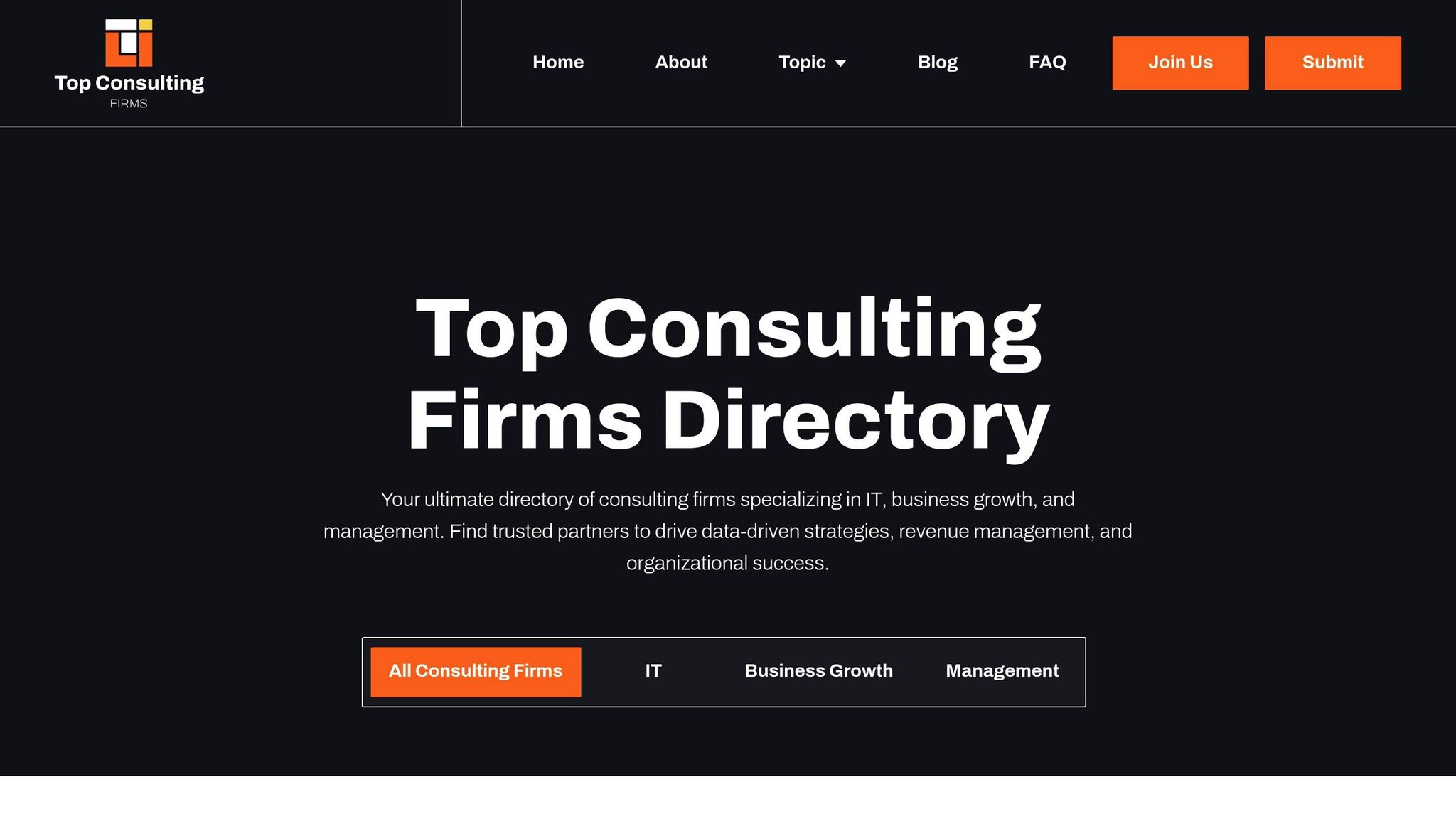Key Takeaways:
- What It Does: AI uses machine learning, predictive analytics, and automation to improve demand forecasting, inventory management, and logistics.
- Benefits: Reduces operating costs by up to 15%, improves forecast accuracy by 20-50%, and cuts delivery times by 10-30%.
- Real-World Examples:
- Core Applications:
- Demand forecasting: Boosts accuracy by up to 40%.
- Inventory optimization: Cuts excess stock by 20%.
- Logistics: Optimizes routes and reduces delays by 30%.
- Implementation Tips:
- Start with small pilot projects.
- Ensure seamless integration with existing systems.
- Focus on high-quality data and continuous model updates.
- Challenges: Success depends on proper data management, employee training, and change management.
AI is reshaping how businesses handle supply chains, helping them save money, improve efficiency, and stay competitive.
10 AI Features That Will REVOLUTIONIZE Your Supply Chain
Core Applications of AI in Supply Chain Management
AI is reshaping supply chains by improving demand forecasting, streamlining inventory management, and optimizing logistics. These areas work together to strengthen supply chain efficiency and adaptability.
Demand Forecasting and Planning
AI is changing the game for demand prediction by analyzing massive datasets that traditional methods can't handle. Machine learning (ML) models sift through sales trends, market data, weather patterns, economic indicators, and even social signals to deliver highly accurate forecasts.
The numbers speak for themselves. Companies have reported forecast accuracy improvements of 30–40% and error reductions of up to 50%. These gains lead to lower costs and better service levels.
For example, in January 2025, Unilever adopted an AI-powered forecasting tool that analyzed consumer purchase habits. This tool boosted forecast accuracy by 25% and cut logistics costs by 10% within six months. Coca-Cola saw similar results in 2024, when its AI-driven system improved forecast accuracy by 30%, slashing stockouts by 15% and reducing excess inventory by 20%.
"AI is transforming demand forecasting by enabling businesses to make data-driven decisions that enhance efficiency and reduce costs." - Jane Doe, Chief Analytics Officer, Tech Innovations Inc.
Accurate demand forecasts are the backbone of efficient inventory and logistics operations.
Inventory Management and Optimization
AI-powered inventory systems have replaced outdated periodic reviews with real-time monitoring and automated restocking. These systems analyze factors like sales speed, seasonal trends, supplier lead times, and market conditions to maintain the perfect balance of stock - avoiding both overstock and stockouts.
The impact is clear: AI-driven inventory management can reduce excess stock by up to 20% while ensuring products are always available, protecting customer satisfaction. Additionally, improved inventory turnover enhances cash flow and working capital efficiency.
In March 2023, Walmart used AI to optimize inventory across 4,700 U.S. stores. The result? An 18% reduction in excess stock and a 12% improvement in product availability. Nike's AI-driven system goes even further, managing production and distribution for over 120,000 SKUs daily. This approach has halved lead times while achieving 99.7% fulfillment accuracy.
Logistics and Network Optimization
AI is revolutionizing logistics with dynamic route planning, predictive maintenance, and automated carrier selection. These systems process real-time data - like traffic, weather, and vehicle performance - to make instantaneous decisions that save time and money.
Optimized routes alone can cut delivery times by 10–30% and transportation costs by 5–15%. Beyond savings, these systems enhance customer satisfaction with reliable service and reduce environmental impact by lowering fuel consumption.
Microsoft's logistics network, for instance, uses AI to slash planning time from 4 days to just 30 minutes, improving accuracy by 24%. DB Schenker employs AI-powered control towers to monitor millions of shipments daily, detecting disruptions within minutes and rerouting shipments automatically. This has reduced delays by 35%.
DHL implemented AI route optimization across its U.S. network in 2022, cutting delivery times by 15% and saving $12 million annually in fuel costs. The initiative, led by Mark Johnson, Head of Logistics Innovation, utilized real-time traffic and weather data integrated with fleet management systems.
Predictive maintenance is another key area. In January 2023, Rio Tinto deployed AI for its mining equipment, reducing unplanned downtime by 30% and saving $8 million in maintenance costs over six months. This project, overseen by CTO Jane Smith, relied on real-time sensor data.
| AI Application Area | Function | Quantitative Impact |
|---|---|---|
| Demand Forecasting | Predicts demand using ML | Up to 50% reduction in errors |
| Inventory Optimization | Real-time tracking, auto-replenish | 20% reduction in excess stock |
| Logistics Optimization | Route planning, predictive maintenance | 10–30% faster delivery |
Siemens has also embraced AI in procurement. Their platform autonomously evaluates suppliers and handles routine orders, cutting procurement cycle times by 60% and achieving 11% cost savings. It even monitors supplier performance and can switch vendors automatically if issues arise.
When applied together, these AI-driven tools create a ripple effect. Better demand forecasting leads to smarter inventory planning, which in turn supports more efficient logistics. Companies that implement AI across all these areas see exponential improvements in their supply chain performance.
How to Implement AI in Supply Chains
Implementing AI in supply chains isn’t just about adopting cutting-edge technology - it’s about careful planning, smooth integration, and preparing your organization for change. Companies that follow a structured approach tend to achieve far better results than those that rush in without proper groundwork.
Connecting AI with Existing Systems
For AI to work effectively, it needs to integrate seamlessly with core enterprise systems like ERP, CRM, and WMS platforms. Without this connection, you risk creating isolated tools that can’t communicate with the rest of your business operations.
Middleware driven by APIs plays a key role here. It acts as a bridge between older systems and modern AI tools, ensuring data flows smoothly across your supply chain. For example, in the mining industry, AI systems analyze sensor data from trucks and drilling equipment. This integration helps predict maintenance needs and optimize autonomous haulage routes, saving fuel and improving reliability by aligning maintenance schedules with operational plans.
Starting small with phased rollouts is another proven strategy. Instead of deploying AI across the entire supply chain, begin with pilot projects in areas like warehouse automation or route optimization. This approach helps identify potential compatibility issues and refine processes before scaling up.
To avoid costly disruptions, create a dedicated test environment where you can validate data flows and system responses before going live. This step ensures that AI systems won’t disrupt existing workflows when fully deployed.
This integration process forms the foundation for effective data management and organizational transformation.
Data and Model Management
AI systems are only as good as the data they’re built on. Poor data quality is a leading cause of failed AI projects, with 45% of implementations falling short due to this issue.
To set your AI initiative up for success, start by standardizing and cleaning your data. Establish clear data dictionaries to define how information should be formatted and stored across your supply chain.
Real-time data is another game-changer. By incorporating information from RFID tags, GPS trackers, and IoT sensors, you can provide AI models with accurate, up-to-date inputs. For example, RFID tags in warehouses minimize manual data entry errors, while GPS trackers on delivery vehicles ensure routing decisions are based on current conditions.
AI models also need to evolve as business conditions change. Continuous model training is essential for maintaining peak performance. Companies like Amazon use digital twins and predictive analytics to retrain models whenever new data becomes available, ensuring accurate forecasting and decision-making.
Regular audits and validation processes are critical for maintaining data integrity over time. These should include automated checks for anomalies, manual reviews of key data sources, and real-time performance monitoring. When models start producing inconsistent results, it’s a signal that retraining may be necessary.
Finally, bias detection protocols are crucial for ensuring fairness and accuracy. Supply chain conditions often shift due to factors like seasonal demand or market disruptions. Regularly testing for biases ensures that AI models remain effective in changing scenarios.
By focusing on high-quality data and continuously refining your models, you’ll create a strong foundation for successful AI adoption.
Change Management for AI Adoption
The success of AI in supply chains often hinges on how well organizations manage change. Strong change management practices ensure employees embrace new technologies rather than resist them.
Executive sponsorship is a key starting point. Leadership must clearly communicate the benefits of AI, allocate the necessary resources, and show unwavering commitment to the transformation process. Experts recommend setting aside 25-30% of the AI project budget specifically for change management.
Training programs are equally important. Employees need to feel confident using new AI systems. Training should cover both technical skills, like navigating AI dashboards, and process changes, such as updated workflows. Well-designed training programs drive higher adoption rates.
Shifting the mindset of an organization requires more than just training - it’s about fostering a culture of innovation. Celebrate early wins from AI pilot projects, share success stories across teams, and encourage experimentation. When employees see AI as a tool that enhances their work rather than replacing them, adoption becomes much easier.
Budgeting for change management should also include resources for communication campaigns, training materials, ongoing support, and incentive programs for early adopters. Skimping on these efforts can lead to low adoption rates, undermining the entire AI initiative.
Finally, transparent communication is critical. Employees need to understand how AI will impact their daily routines, what new skills they’ll need, and how the company plans to support them. Regular town halls, training sessions, and feedback collection can help address concerns and keep the momentum going.
The best AI implementations treat technology and organizational change as equally important. Companies that excel in both areas unlock significant gains in efficiency and performance, making their AI investments more than worthwhile.
sbb-itb-97f6a47
Measuring AI Impact in Supply Chains
Evaluating the impact of AI in supply chains is essential to confirm whether your investments are paying off and to identify areas for improvement. Without proper metrics, it's challenging to determine if your AI initiatives are delivering the expected outcomes or if adjustments are needed. Let’s dive into the key metrics and tools that can help measure success.
Key Performance Metrics
To assess the effectiveness of AI applications in your supply chain, focus on metrics that align with your business goals. One of the most important is cost savings. Studies show that AI-driven supply chain operations can reduce operational costs by 10–15%. This includes both direct savings, like lower labor costs, and indirect savings from improved efficiency.
Another vital metric is forecast accuracy. AI-powered demand forecasting tools can achieve accuracy improvements of up to 85% in certain industries. By comparing pre- and post-AI performance, you can measure improvements in forecast accuracy and inventory turnover.
Inventory turnover is another critical indicator. AI-driven inventory management systems can reduce excess stock by 20–50%. To track this, divide the cost of goods sold by the average inventory value and monitor changes over time.
Additionally, response time to disruptions is becoming increasingly important. This metric tracks how quickly your AI-enabled supply chain can adapt to unexpected events, which is crucial in today’s landscape of frequent disruptions.
| Metric | Typical Improvement with AI | Measurement Method |
|---|---|---|
| Forecast Accuracy | Up to 85% | Compare predicted vs. actual demand |
| Inventory Reduction | 20–50% | Track excess stock levels over time |
| Operational Cost Reduction | 10–15% | Monitor total supply chain expenses |
| Order Fulfillment Speed | Up to 25% | Measure time from order to shipment |
| Manual Error Reduction | Up to 50% | Count errors before and after AI use |
Other useful metrics include delivery time reduction, fuel cost savings, and warehouse efficiency gains. For instance, AI-enabled route optimization can cut delivery times by 15% and reduce fuel costs by 12%. Similarly, AI-powered warehouse automation can boost order fulfillment speed by up to 25% while cutting manual errors by 50%.
Real-Time Monitoring Tools
Real-time monitoring tools, such as business intelligence dashboards, are indispensable for tracking AI performance. These dashboards pull data from ERP systems, IoT devices, and TMS platforms to provide continuous visibility. Instead of discovering issues days or weeks later, these tools allow for immediate detection and resolution. For example, Target’s AI platform processes millions of data points every hour, reducing out-of-stock incidents and shortening disruption response times from days to hours.
Effective dashboards also leverage anomaly detection and predictive analytics. They flag deviations - like unexpected drops in inventory levels or surges in delivery times - so managers can act quickly. Predictive analytics go a step further by forecasting potential problems and suggesting solutions, such as alternative sourcing options. Seamless integration with existing ERP and supply chain systems is crucial to ensure smooth data flow and scalability.
A standout example of real-time monitoring is DB Schenker's AI-powered control towers. Their system identifies disruptions within three minutes, reducing delay incidents by 35% and delivering substantial annual savings.
ROI Analysis for AI Investments
To measure the return on investment (ROI) for AI, compare the total implementation costs against the measurable benefits. Start by documenting all expenses, including technology, system integration, training, and maintenance. Don’t forget to include change management costs, which can account for 25–30% of your total AI project budget.
Quantify direct benefits such as reductions in labor, inventory carrying, and transportation costs. For instance, one pilot project reported a 30% drop in excess stock and a 20% improvement in order fulfillment within the first year.
Indirect benefits like improved customer satisfaction, reduced supply chain risks, and better decision-making also add long-term value, even if they’re harder to measure.
Techniques like break-even analysis can determine when your AI investment will start to deliver positive returns. Many projects see payback within 18–24 months, though this varies by industry and project scope.
Starting with a pilot project is a practical way to assess ROI on a smaller scale. For example, Microsoft’s global logistics network used AI automation to cut planning time from four days to just 30 minutes, while improving accuracy by 24%. These results can help build confidence for larger-scale AI adoption.
Regular audits are essential to ensure continued AI effectiveness. As market conditions and business needs evolve, AI models may require retraining. Evaluating both quantitative outcomes (like cost savings) and qualitative benefits (like better employee morale and customer service) ensures long-term success.
For businesses looking for expert support, consulting firms specializing in supply chain optimization can provide valuable insights. The Top Consulting Firms Directory connects businesses with experts in data integration, KPI selection, ROI analysis, and change management for AI projects.
Consulting Resources and Tools for AI Implementation
When it comes to successfully integrating AI into your supply chain, it’s not just about the technology - it’s about having the right tools and expert guidance. Combining advanced platforms with professional consulting can make all the difference in aligning AI strategies with your business goals.
Top AI Platforms for Supply Chains
Several AI platforms have proven their worth in transforming supply chains across the US. SAP Integrated Business Planning is a standout for its advanced demand forecasting and scenario planning. It offers real-time analytics and integrates seamlessly with ERP systems, making it a go-to for manufacturing and retail businesses.
AWS Supply Chain brings unmatched cloud-native flexibility. Its real-time monitoring and smooth integration with other AWS services make it particularly appealing for logistics and e-commerce companies looking for scalable, cost-effective solutions.
Microsoft Dynamics 365 Supply Chain Management offers a comprehensive suite of AI-driven tools, including demand forecasting and inventory optimization. Its tight integration with other Microsoft applications makes it an ideal choice for businesses already using Microsoft’s ecosystem.
When choosing an AI platform, focus on key factors like data integration, scalability, and real-time analytics. For instance, platforms that integrate easily with your ERP or SCM systems can save time and resources. Scalability ensures the system grows with your business, while real-time analytics help you respond quickly to disruptions. Additionally, compliance with US regulations like the California Consumer Privacy Act (CCPA) is a must.
Consider platforms with proven results. For example, in 2022, a major US logistics company used SAP’s AI-enabled route optimization to cut annual fuel costs by 18% and delivery times by 12%. By incorporating real-time traffic and weather data, they saved $4.5 million annually and improved on-time delivery rates. These success stories highlight how AI platforms can transform supply chains into efficient, data-driven systems.
Role of Consulting Firms in AI Adoption
Even the most advanced AI platforms can fall short without the right expertise. Consulting firms play a vital role in ensuring AI solutions are implemented effectively and aligned with business objectives. Their knowledge of digital transformation helps businesses navigate the complexities of integrating AI into existing operations.
One of their key contributions is strategy development. Consultants conduct in-depth process audits, define clear automation goals, and set measurable KPIs to align AI initiatives with your business strategy. This proactive approach helps avoid common pitfalls during implementation.
Change management is another critical area where consulting firms add value. Poor change management is a leading cause of AI project failures, contributing to 68% of unsuccessful implementations. Successful projects typically allocate 25–30% of their budget to change management and user adoption. Consulting firms also ensure compliance with US regulations and provide user training, which is essential for smooth organizational transitions.
A real-world example of consulting success is Nike’s AI-driven production and distribution system. With expert consulting, Nike reduced lead times by 50% while achieving a 99.7% fulfillment accuracy rate. This demonstrates how the right guidance can amplify the impact of AI tools.
Top Consulting Firms Directory

Finding the right consulting partner for your AI project can be a challenge, especially when expertise in both AI technology and supply chain operations is required. The Top Consulting Firms Directory is a valuable resource for US businesses looking to connect with experienced consulting partners.
This online platform highlights firms with a strong track record in areas like IT, business growth, and strategic management - key elements for successful AI implementation. What sets this directory apart is its focus on firms with proven success in supply chain optimization. By vetting firms for their expertise, the directory helps businesses avoid the risks of working with less experienced partners.
The directory emphasizes consulting firms skilled in data integration, technology governance frameworks, and regulatory compliance. These capabilities are essential for implementing AI solutions that can monitor performance, detect bias, and support ethical decision-making.
For businesses just starting their AI journey, the directory identifies partners who specialize in pilot projects and phased implementations. These firms can guide you through testing AI tools in high-impact areas like demand forecasting or logistics optimization before scaling up.
Additionally, the directory connects businesses with consultants experienced in real-time monitoring and rapid response systems. As supply chain disruptions become more frequent, having experts who can configure AI tools for quick disruption detection and resource reallocation is invaluable. With the right consulting partner, businesses can bridge the gap between advanced technology and operational excellence.
Conclusion
AI is reshaping supply chains across the U.S., delivering impressive results like 23–31% cost savings and 30–40% improvements in forecasting accuracy. Businesses adopting AI solutions are seeing benefits that extend well beyond simple automation.
Consider the examples discussed earlier: Microsoft slashed its planning process from 4 days to just 30 minutes while improving accuracy by 24%. Home Depot boosted in-stock availability by 15% and saved $1.2 billion annually. Meanwhile, Target cut out-of-stock issues by 40% and reduced response times from days to mere hours.
Achieving these outcomes, however, requires more than just technology. Strategic planning, effective change management, and expert guidance are critical. Without allocating 25–30% of resources to change management, nearly half of AI projects fail. Success comes from combining advanced AI tools with high-quality data and organizational readiness.
This is where experienced consulting partners become essential. The Top Consulting Firms Directory can connect businesses with professionals who understand both the technical and operational challenges of integrating AI into supply chains. These partnerships ensure that companies not only overcome technical hurdles but also prepare their teams for the significant changes AI brings.
Looking ahead, the potential for AI in supply chains is immense. From real-time decision-making to sustainability improvements and full-scale automation, the technology is driving continuous evolution. Companies that begin with pilot projects in key areas like demand forecasting or logistics optimization - and scale based on measurable ROI - set themselves up for long-term success. The real key lies in merging cutting-edge AI platforms with expert guidance to achieve operational excellence.
The shift is happening now. Embracing AI today positions your business to stay ahead of the competition tomorrow.
FAQs
How does AI enhance demand forecasting, and what are the key benefits for businesses?
AI has transformed demand forecasting by diving deep into massive datasets to uncover patterns and trends that traditional approaches often overlook. With machine learning algorithms at its core, AI can analyze historical sales figures, market behaviors, and even external influences like weather or economic shifts to deliver highly precise predictions.
For businesses, this means smarter inventory management - avoiding both overstock and stockouts - and optimized resource allocation, which translates to significant cost savings. On top of that, AI-powered forecasting equips companies to adapt swiftly to market changes, enhancing customer satisfaction and opening the door to increased revenue opportunities.
What challenges do businesses face when adopting AI in supply chains, and how can they address them?
Implementing AI in supply chains comes with its fair share of hurdles. High upfront costs, inconsistent data quality, and internal resistance to change are some of the most common challenges. Many companies also face difficulties when trying to integrate AI with their existing systems or ensuring their teams have the necessary skills to operate and benefit from these advanced technologies.
To address these challenges, businesses should start by setting clear, achievable goals for adopting AI. Focusing on projects with quantifiable outcomes can make the transition smoother and more rewarding. Providing employees with targeted training and encouraging a mindset that embraces innovation can also make a significant difference. For additional support, collaborating with seasoned consultants or firms that specialize in AI implementation can offer the expertise and direction needed to navigate this complex process.
How do consulting firms help businesses adopt AI for supply chain management?
Consulting firms are instrumental in guiding businesses through the process of incorporating AI into supply chain management. These firms offer specialized advice on digital transformation, strategy planning, and refining processes - all critical for boosting supply chain performance and adaptability.
With their expertise, consulting firms help businesses choose the most suitable AI tools, adopt effective practices, and tackle hurdles such as data integration and employee training. Their involvement simplifies the transition and helps businesses get the most out of their AI investments.


